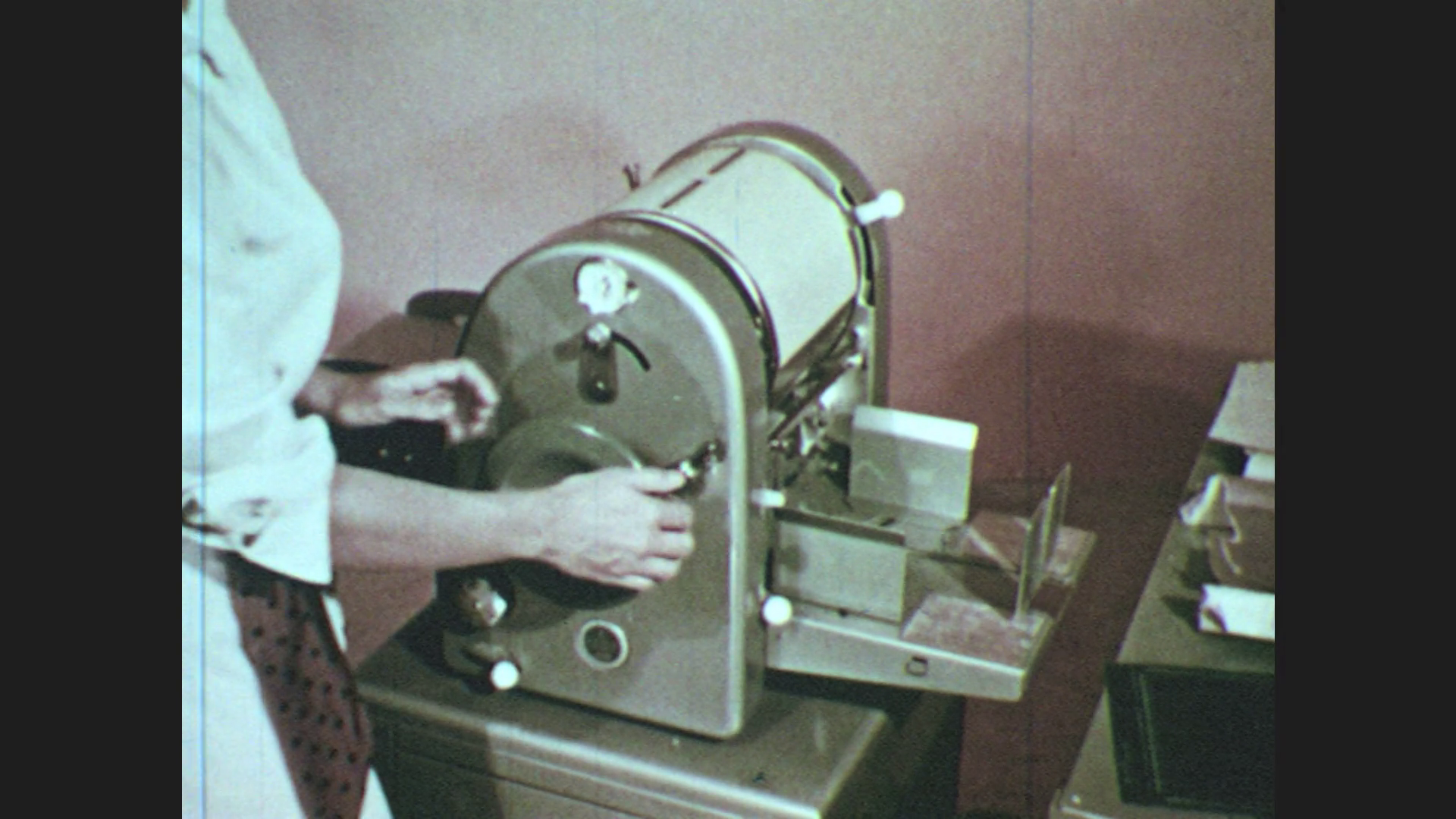
User operating a mimeograph machine in the 1950s. Courtesy of Storyblocks.
In the 2017-18 academic year I executed a lively experiment integrating poetry into LMC 3403, a traditional technical communication course at Georgia Tech as the direct result of receiving a Poetry@Tech pedagogy development grant. Technical communication is defined by Elizabeth Tebeaux and Sam Dragga as writing “that occurs in a business or workplace setting” (3) that showcases “accuracy, clarity, conciseness, readability, usability, and correctness” (8). Other scholars of technical communication emphasize that this form of writing can be read selectively, utilizes visual components to aid readers in understanding, and provides readers with necessary data in order to help them make decisions or complete tasks. Technical communication is regularly thought of as “precise,” (Anderson 12) “concise,” (Anderson 15) and the very “backbone of workplace communications” (Johnson-Sheehan 7) by academics and by practitioners alike. It’s a form of writing that appears simple at first glance but in actuality requires detailed description, process segmenting, and a careful understanding on the part of the writer/designer of the ideal end user and/or reader and their purposes in utilizing a specific communication. Students training in engineering, science, mathematics, and business can all benefit from studying technical communication and considering the ways that the field can help them to effectively design and improve professional documents, posters, presentations, and documentation such as instructions, training manuals, or quickstart guides.
For me, the Poetry@Tech grant was absolutely pivotal to instilling art and the humanities back into my heavily STEM-focused curricular design. The grant allowed me the freedom and flexibility to further experiment with redesigning a traditional Technical Communication classroom genre: the instructional artifact. Instructional artifacts include package inserts, quick reference guides that provide shortcuts of the sort you might find with new software, procedures for tasks including selecting a candidate for a position or accepting a winning bid for a project, human resource manuals for employees, or training operation manuals for a range of highly specialized tasks. Instructional artifacts nearly always have both a written and visual component. However, some may also have oral or electronic components as well. (Think of videos, for instance, that tell you how to self-install your cable box.) In redesigning, I was able to offer students a chance to combine teamwork, visual design, user testing, end user and client profile development, revision, and budget management as they worked together to complete this reconstructed project. After several semesters of teaching students how to prepare instructions, I realized that I needed to strengthen and emphasize feeling and creativity in my own project design. The instructions that I received from students were competent and met the needs of our clients but were lacking any sense of “powerful feeling” on the part of the creators (Wordsworth). The instructions felt rote, mechanical, impersonal. It was time to rethink things. In reverse designing my assignment, I realized that I needed to:
- offer my students more chances for team building;
- to help them develop their skills in visual design and process segmenting;
- to reverse engineer something that they themselves had built;
- and to offer them an opportunity for further reflection about how the project had helped them to grow as thinkers and as communicators.
As I was considering ways that I could transform my instructional artifact project, inspiration struck in an airport coffee shop. My flight had been slightly delayed and I was idly scrolling social media, only half focused on the usual cat memes, The Onion headlines, and political outrage that seem to make up my feed these days. In the midst of this assemblage, I noticed a post from Richard Utz, the Chair of the School of Literature, Media, and Communication, highlighting a short story dispenser he had encountered at a French airport. I started to daydream about the possibilities of building a smaller, more portable version of this public-facing, interactive machine. The daydream turned to sketching, some Googling, and then thinking about my own free reading time and preferences. (Due to my teaching and service responsibilities, manuscript preparation, and a lengthy commute, I personally prefer audiobooks or poetry these days.) Suddenly, I was imagining an interactive poetry dispenser.
As the daydream started to solidify, the possibilities of integrating poetry into a traditional technical communication classroom began to become more and more tangible. It was time to take a step back and to start concretely theorizing what the project needed to accomplish in relation to traditional technical communication genres. As my courses are affiliated with the Georgia Tech Center for Serve-Learn-Sustain, it’s important to me that the dispensers be built using sustainable materials. I also knew that minimal working budgets were an important criterion. Finally, it was important to remember that the goal of creating this dispenser in the technical communication classroom was to give students a chance to collaborate, to build something, and to then practice reverse engineering for the purpose of creating instructions and troubleshooting guides.
Utilizing questions raised by Carolyn D. Rude in her article “Mapping the Research Questions in Technical Communication,” I decided I wanted to address the following pedagogical, practice, and social change issues in my redesigned instruction project:
Pedagogy: What should be the content of our courses and curriculum? How shall we teach students best practices, history, and possibilities? How shall we negotiate competing claims for content and pedagogical methods and compete for academic resources?
Practice: How should texts be constructed to work effectively and ethically? What design practices include international users and users with disabilities? What are best practices of text development and design? How can content be managed for reuse?
Social change: How do texts function as agents of knowledge making, action, and change? (Rude 176)
One of the biggest pedagogical opportunities with this redesigned assignment was the new emphasis on visual, interactive design principles, reverse engineering, and creating instructions for clients. In thinking through the many different aspects of this project, I decided that it was time to make this project a team project rather than one constructed by individual students. Student teams were tasked with creating interactive poetry dispensers using at least 75% recycled content and a working budge of $25 that would be on display at Poetry@Tech offices and in the Stephen C. Hall building on campus. Thinking through Rude’s questions pushed me to consider ways to make my own assignment sheets (a variant on instructions themselves) and grading rubrics more useful for student groups.
Rude’s emphasis on practice and social change compelled me to consider additional ways to get my clients and course partners more involved with this particular project, one that took place in the early stages of the semester. A class session with Travis Denton, the McEver Chair in Poetry at Georgia Tech and Associate Director of Poetry@Tech aided students across sections A, B, and G in thinking more about ways to read poetry for form and meter, the many different genres of poetry, and how to read poetry with joy. As we worked through Billy Collins’s “Introduction to Poetry” in class with Denton’s guidance, several students could be seen wryly chuckling at the end, when Collins’ narrator notes that the readers he’s instructing to read a poem struggle, “beating it [the poem] with a hose / to find out what it really means.” Students in sections A and G were particularly comfortable in sharing that their earlier experiences with poetry in the classroom had been mostly unhappy. As these students struggled in their high school classes to understand meter and rhythm, to work out complicated diction, or to find a meaning that they felt they could further unpack in response to a standardized essay prompt, they missed chances to explore the musicality and joy of poetry, the way it compresses ideas, and allows for shared glimpses of thought. The chance to think more alongside Denton about different poetic forms, how poetry can help readers sort through complicated feelings, 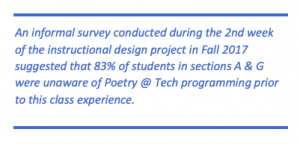 how poetry can create shared moments of cultural reference, and the importance of rhythm and meter, especially in the context of lyric poetry, proved hugely useful. Being able to interact with the client for this project and finding out more about his mission, end users (Poetry@Tech audiences, students, faculty, and other Atlanta area writing communities), and personal interests aided students in taking more risks in dispenser construction, the design of their instructions, and the selection ofthe poems for the dispensers than they otherwise may have taken.
how poetry can create shared moments of cultural reference, and the importance of rhythm and meter, especially in the context of lyric poetry, proved hugely useful. Being able to interact with the client for this project and finding out more about his mission, end users (Poetry@Tech audiences, students, faculty, and other Atlanta area writing communities), and personal interests aided students in taking more risks in dispenser construction, the design of their instructions, and the selection ofthe poems for the dispensers than they otherwise may have taken.
After our session with Denton, I assigned textbook chapters and designed lessons on the ways that visual design can best be utilized in technical communications. A small group project conducted in all three classes taught in Fall 2017 allowed students to critique instructions that they had received in packaging materials, looking more closely at the ways that fonts, margins, subheadings, and exploded diagrams impacted clarity, readability, and usability. We also reviewed Poetry@Tech’s existing website, posters, and other marketing materials. This work not only helped the project teams make design choices centered on best practices, it also helped them to consider the possibilities of how end users might use instructions to operate and repair the poetry dispensers. As each group proceeded, they worked together to think more concretely about how personnel associated with Poetry@Tech, including guest poets, event visitors, and Georgia Tech faculty and staff might use their instructions (and their dispensers) as effectively and efficiently as possible. Throughout the design process, students additionally engaged with websites such as the Academy of American Poets and Poetry Foundation as they worked to determine which genres and authors they wished to highlight in their work. (Students in each section seemed to especially respond to the work of contemporary poets Victoria Chang, Aimee Nezhukumatathil, Anis Mojgani, Christopher Collins, and more classical poets such as Christina Rossetti and George Herbert.)
Usability presented challenges that ultimately aided the process of instruction creation. One group, from section B, building a variant of a paper towel dispenser, realized after transporting their heavy and unwieldy design up and down Freshman Hill several times in the space of one day that users with disabilities might not be able to easily access and use their design. (They chose to slightly redesign, using lighter wood components that need to be assembled in stages.) Another student group, from section G, attended a Poetry@Tech reading together and, after noticing the average age of audience members and completing a reader profile (another traditional Technical Communication genre), decided to rethink their idea of filling their dispenser with lyrics by popular singers such as Lady Gaga, Miley Cyrus, and Carrie Underwood. Finally, a group from section A decided, after attending the same reading as the students from section G and encountering the work of poet Tyehimba Jess, to concentrate their efforts on poetry emphasizing social justice issues. With so many available options for dispenser design and for possible poems to include, it was sometimes easy for all of us, in watching the dispensers come together, to forget the main purpose of the assignment: to build clear, readable, usable instructions that met the needs of our client.
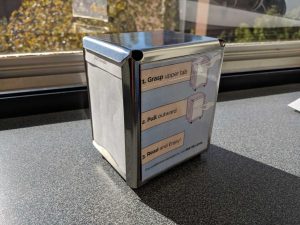
Poetry Dispenser created by team in LMC 3403-B, Fall 2017.
One especially interesting result of this assignment in the Fall classes involved watching students work together to unravel the complex meanings of the word “machine.” (I changed the label “poetry machine” to “poetry dispenser” when redesigning this project for a Spring 2018 class.) My students, primarily business and computer science majors, are fascinated by the field of machine learning and the rich possibilities that it offers. Although they had met our client, were aware of our limited operating budget, and had been advised that the machine/dispenser should be as interactive as possible, several teams from both A and G sections were firmly insistent that websites, Twitter and Facebook bots, and Google Chrome extensions would be the best way to get Poetry@Tech’s end users to engage directly with poetry. Two of the most vocally strident student project managers indicated later that the process of constant retooling and user feedback reminded them that they won’t always be “designing in a bubble” (Student Project Manager A3) and that they need to be responsive to client desires and the needs of the client’s end users. Student Project Manager A5 observed that it was hard for their team, consisting mainly of computer science majors, to “think of the possibility of machines other than computers” and that as a result, his team decided to “solely design for computers” despite early feedback provided by both the instructor and the client.
Through this experience, I learned that I needed to more directly coach students about simple machines such as pulleys and levers, highlighting tactility and showcasing the ways that physical recycled articles could be used to create things such as straw dispensers. While we do tend to try designing for technology as much as possible, it’s important for technical communicators to remember that our clients and end users may not have computers, online access, or other features that we may take for granted. The teams that attended a Poetry@Tech event and shared video reflections regarding the experience of the reading and what they observed about audience members and their response to poetry prior to beginning their design process tended to opt for a more tactile, non-Internet based, highly portable and tactile machine following their experiences. They recognized that the limitations of physical space, the varied and demanding tasks of event personnel, and even the socioeconomic makeup of individual audience members could (and should) impact their design process as they respected the needs of their client.
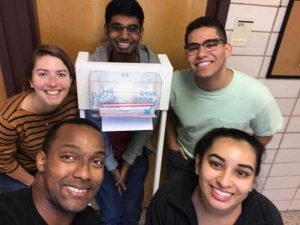
Team with their Poetry Dispenser, Fall 2017
Redesigning this particular project for the 2017-18 academic year gave shy students a chance to emerge as team leaders and for others to recognize the importance of teamwork, especially when working with an unfamiliar subject. As a poet myself, it was a lot of fun to discuss poetic process and form with students during this project. It was truly pleasurable reminding students that poetry is highly technical and that poets, like technical writers, must be attentive to issues such as word choice and design. One of the most exciting end results was being able to help some students, “trained out of enjoying poetry in high school” (to quote one anonymous student from Fall 2018), to return to an appreciation of poetry as an art form. Another personal highlight involved establishing for the whole class that contemporary ethnic poetry and lyrics can also be appreciated as representative of poetic form, despite their lack of inclusion in poetry anthologies, something I accomplished by sharing some examples of my own favorite works during class lectures. (Examples included Gerard Manley Hopkins’ “The Windhover,” George Herbert’s “The Altar,” Edward Lear’s “How Pleasant to Know Mr. Lear,” Ofelia Zepeda’s “Carrying Our Words,” and Lucille Clifton’s “The Earth is a Living Thing,” among others.)
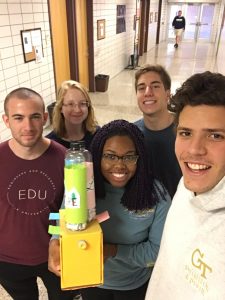
Team with their Poetry Dispenser, Fall 2017
Along the way, I learned quite a bit about current college students and their reading and writing practices. Seven anonymous students self-identified as poets, with one suggesting that “the physical act of poetry aids me in managing my stress levels.” Three more noted that they enjoy reading poetry in their native languages. One student used his own experiences as a talented lyricist affiliated with a local band to help coach his teammate struggling with interpreting poems by Emily Dickinson that were included in their dispenser. Finally, a student from section B observed that she enjoyed the project because she “had a chance to see professors interacting with each other, clearly taking joy in discussing a piece of literature together.” Her comment reminds me that as teachers we should, whenever possible, indicate to our students why literature matters to us as individuals and how it helps us to actively participate in broader, long-established communities of learning. In reimagining the project during Spring 2018, I focused on improving the clarity of my own instructions and the rubric by integrating additional visual design components. I also urged students more regularly to focus on the expressed needs of our client and their ideal end users.
In the end, the Poetry Dispenser Project proved to be one of my most radical pedagogical experiments to date in the technical communication classroom. In considering the work that my students created, I recognize that they faced multiple challenges: collaboration with students from other majors and cultural backgrounds, learning more about a client and the client’s needs, having to complete a project with some design flexibility and moving goalposts, dealing with limited budgets, managing a tight project schedule, and learning how to segment tasks among team members. Ultimately, this redesigned instructional artifact project proved useful in replicating many of the day-to-day issues faced by professional technical communicators in a classroom setting.
Works Cited
Tebeaux, Elizabeth and Sam Dragga. The Essentials of Technical Communication. 4th ed. Oxford UP, 2008.
Anderson, Paul. Technical Communication: A Reader-Centered Approach. 8th ed. Cengage, 2014.
Johnson-Sheehan, Richard. Technical Communication Today. 5th ed. Pearson, 2015.
Wordsworth, William. “Preface to Lyrical Ballads.” (1802). The Major Works. Ed. Stephen Gill. Oxford, 2000. pp. 595-616.
Lee, Dami. “This short story dispenser helps you pass the time with literature.” 8 Jan. 2018,
https://www.theverge.com/2018/1/7/16860990/short-edition-short-story-dispenser-ces-2018. Accessed 29 Dec. 2018.
Rude, Carolyn. “Mapping the Research Questions in Technical Communication.” Journal of Business and Technical Communication. vol. 23, no..2, 2009, pp. 174-215.
Collins, Billy. “Introduction to Poetry.” (1996). Poetry Foundation. https://www.poetryfoundation.org/poems/46712/introduction-to-poetry. Accessed 29 Dec. 2018.
Greene, Rebekah. “Poetry @ Tech Student Awareness Among Junior and Senior Students Enrolled in LMC 3403.” Informal Survey. 28 Aug. 2017.
“Simple Machines for Kids: Science and Engineering for Children.” YouTube, uploaded by FreeSchool, 22 June 2016. https://www.youtube.com/watch?v=fvOmaf2GfCY
“How to Make Straw Dispenser from Cardboard at Home Easy DIY.” YouTube, uploaded by Pinc Share, 26 July 2017. https://www.youtube.com/watch?v=SYCGywuKdtA
Anonymous Student. “Thank-a-Teacher Note.” 16 Dec. 2017.
Buxton, Margaret. “To Dr. Rebekah Greene.” 8 Dec. 2017.

